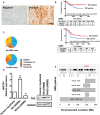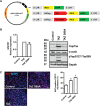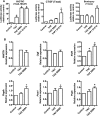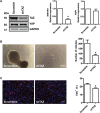The Hippo effector TAZ (WWTR1) transforms myoblasts and TAZ abundance is associated with reduced survival in embryonal rhabdomyosarcoma
- PMID: 27184927
- PMCID: PMC4995731
- DOI: 10.1002/path.4745
The Hippo effector TAZ (WWTR1) transforms myoblasts and TAZ abundance is associated with reduced survival in embryonal rhabdomyosarcoma
Abstract
The Hippo effector YAP has recently been identified as a potent driver of embryonal rhabdomyosarcoma (ERMS). Most reports suggest that the YAP paralogue TAZ (gene symbol WWTR1) functions as YAP but, in skeletal muscle, TAZ has been reported to promote myogenic differentiation, whereas YAP inhibits it. Here, we investigated whether TAZ is also a rhabdomyosarcoma oncogene or whether TAZ acts as a YAP antagonist. Immunostaining of rhabdomyosarcoma tissue microarrays revealed that TAZ is significantly associated with poor survival in ERMS. In 12% of fusion gene-negative rhabdomyosarcomas, the TAZ locus is gained, which is correlated with increased expression. Constitutively active TAZ S89A significantly increased proliferation of C2C12 myoblasts and, importantly, colony formation on soft agar, suggesting transformation. However, TAZ then switches to enhance myogenic differentiation in C2C12 myoblasts, unlike YAP. Conversely, lentiviral shRNA-mediated TAZ knockdown in human ERMS cells reduced proliferation and anchorage-independent growth. While TAZ S89A or YAP1 S127A similarly activated the 8XGTIIC-Luc Hippo reporter, only YAP1 S127A activated the Brachyury (T-box) reporter. Consistent with its oncogene function, TAZ S89A induced expression of the ERMS cancer stem cell gene Myf5 and the serine biosynthesis pathway (Phgdh, Psat1, Psph) in C2C12 myoblasts. Thus, TAZ is associated with poor survival in ERMS and could act as an oncogene in rhabdomyosarcoma. © 2016 The Authors. The Journal of Pathology published by John Wiley & Sons Ltd on behalf of Pathological Society of Great Britain and Ireland.
Keywords: Hippo pathway; TAZ; WWTR1; embryonal rhabdomyosarcoma; myoblasts.
© 2016 The Authors. The Journal of Pathology published by John Wiley & Sons Ltd on behalf of Pathological Society of Great Britain and Ireland.
Figures






Similar articles
-
Analysis of the relationship between the KRAS G12V oncogene and the Hippo effector YAP1 in embryonal rhabdomyosarcoma.Sci Rep. 2018 Oct 23;8(1):15674. doi: 10.1038/s41598-018-33852-7. Sci Rep. 2018. PMID: 30353028 Free PMC article.
-
Common and Distinctive Functions of the Hippo Effectors Taz and Yap in Skeletal Muscle Stem Cell Function.Stem Cells. 2017 Aug;35(8):1958-1972. doi: 10.1002/stem.2652. Epub 2017 Jun 27. Stem Cells. 2017. PMID: 28589555 Free PMC article.
-
TAZ and YAP are frequently activated oncoproteins in sarcomas.Oncotarget. 2016 May 24;7(21):30094-108. doi: 10.18632/oncotarget.8979. Oncotarget. 2016. PMID: 27129148 Free PMC article.
-
Non-hippo kinases: indispensable roles in YAP/TAZ signaling and implications in cancer therapy.Mol Biol Rep. 2023 May;50(5):4565-4578. doi: 10.1007/s11033-023-08329-0. Epub 2023 Mar 6. Mol Biol Rep. 2023. PMID: 36877351 Review.
-
Physiological and pathological roles of the Hippo-YAP/TAZ signaling pathway in liver formation, homeostasis, and tumorigenesis.Cancer Sci. 2022 Jun;113(6):1900-1908. doi: 10.1111/cas.15352. Epub 2022 Apr 17. Cancer Sci. 2022. PMID: 35349740 Free PMC article. Review.
Cited by
-
The essential role of TAZ in normal tissue homeostasis.Arch Pharm Res. 2021 Mar;44(3):253-262. doi: 10.1007/s12272-021-01322-w. Epub 2021 Mar 26. Arch Pharm Res. 2021. PMID: 33770379 Free PMC article. Review.
-
How Phosphofructokinase-1 Promotes PI3K and YAP/TAZ in Cancer: Therapeutic Perspectives.Cancers (Basel). 2022 May 18;14(10):2478. doi: 10.3390/cancers14102478. Cancers (Basel). 2022. PMID: 35626081 Free PMC article.
-
Yap/Taz activity is associated with increased expression of phosphoglycerate dehydrogenase that supports myoblast proliferation.Cell Tissue Res. 2024 Mar;395(3):271-283. doi: 10.1007/s00441-023-03851-w. Epub 2024 Jan 6. Cell Tissue Res. 2024. PMID: 38183459 Free PMC article.
-
The role of serine metabolism in lung cancer: From oncogenesis to tumor treatment.Front Genet. 2023 Jan 9;13:1084609. doi: 10.3389/fgene.2022.1084609. eCollection 2022. Front Genet. 2023. PMID: 36699468 Free PMC article. Review.
-
PLCε knockdown prevents serine/glycine metabolism and proliferation of prostate cancer by suppressing YAP.Am J Cancer Res. 2020 Jan 1;10(1):196-210. eCollection 2020. Am J Cancer Res. 2020. PMID: 32064161 Free PMC article.
References
MeSH terms
Substances
Grants and funding
LinkOut - more resources
Full Text Sources
Other Literature Sources
Research Materials
Miscellaneous

